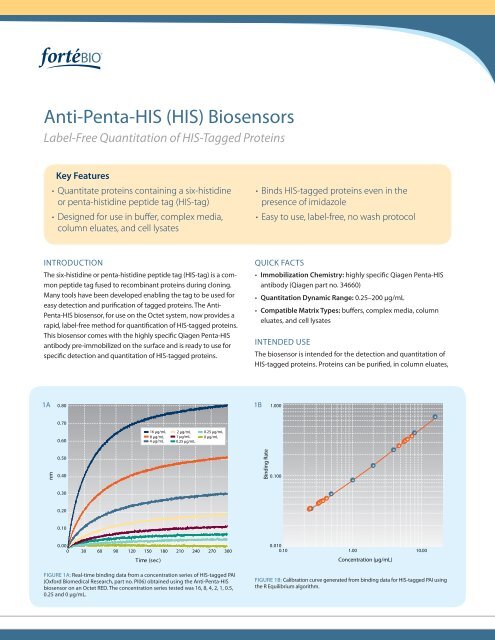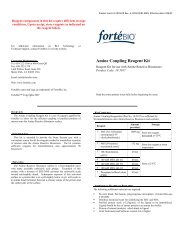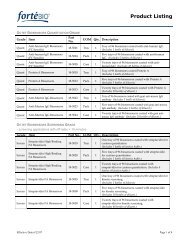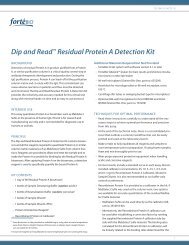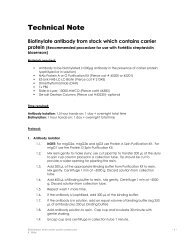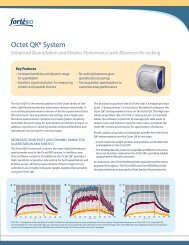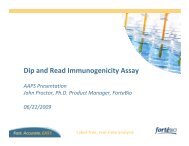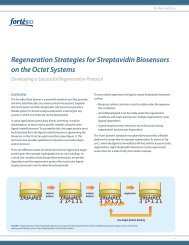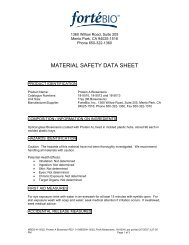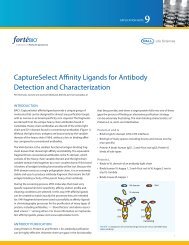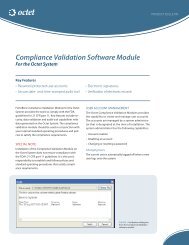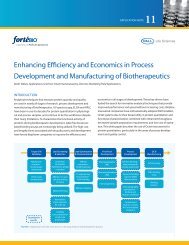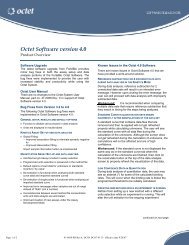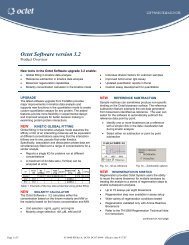Anti-Penta-HIS (HIS) Biosensors - ForteBio
Anti-Penta-HIS (HIS) Biosensors - ForteBio
Anti-Penta-HIS (HIS) Biosensors - ForteBio
Create successful ePaper yourself
Turn your PDF publications into a flip-book with our unique Google optimized e-Paper software.
Document Title<br />
<strong>Anti</strong>-<strong>Penta</strong>-<strong>HIS</strong> (<strong>HIS</strong>) <strong>Biosensors</strong><br />
Label-Free Quantitation of <strong>HIS</strong>-Tagged Proteins<br />
Key Features<br />
• Quantitate proteins containing a six-histidine<br />
or penta-histidine peptide tag (<strong>HIS</strong>-tag)<br />
• Designed for use in buffer, complex media,<br />
column eluates, and cell lysates<br />
• Binds <strong>HIS</strong>-tagged proteins even in the<br />
presence of imidazole<br />
• Easy to use, label-free, no wash protocol<br />
Introduction<br />
The six-histidine or penta-histidine peptide tag (<strong>HIS</strong>-tag) is a common<br />
peptide tag fused to recombinant proteins during cloning.<br />
Many tools have been developed enabling the tag to be used for<br />
easy detection and purification of tagged proteins. The <strong>Anti</strong>-<br />
<strong>Penta</strong>-<strong>HIS</strong> biosensor, for use on the Octet system, now provides a<br />
rapid, label-free method for quantification of <strong>HIS</strong>-tagged proteins.<br />
This biosensor comes with the highly specific Qiagen <strong>Penta</strong>-<strong>HIS</strong><br />
antibody pre-immobilized on the surface and is ready to use for<br />
specific detection and quantitation of <strong>HIS</strong>-tagged proteins.<br />
Quick facts<br />
• Immobilization Chemistry: highly specific Qiagen <strong>Penta</strong>-<strong>HIS</strong><br />
antibody (Qiagen part no. 34660)<br />
• Quantitation Dynamic Range: 0.25–200 µg/mL<br />
• Compatible Matrix Types: buffers, complex media, column<br />
eluates, and cell lysates<br />
Intended Use<br />
The biosensor is intended for the detection and quantitation of<br />
<strong>HIS</strong>-tagged proteins. Proteins can be purified, in column eluates,<br />
1A<br />
0.80<br />
1B<br />
1.000<br />
0.70<br />
0.60<br />
16 µg/mL<br />
8 µg/mL<br />
4 µg/mL<br />
2 µg/mL<br />
1 µg/mL<br />
0.25 µg/mL<br />
0.25 µg/mL<br />
0 µg/mL<br />
nm<br />
0.50<br />
0.40<br />
Binding Rate<br />
0.100<br />
0.30<br />
0.20<br />
0.10<br />
0.00<br />
0 30 60 90 120 150 180 210 240 270 300<br />
T ime (sec)<br />
0.010<br />
0.10 1.00<br />
10.00<br />
Concentration (µg/mL)<br />
FIGURE 1A: Real-time binding data from a concentration series of <strong>HIS</strong>-tagged PAI<br />
(Oxford Biomedical Research, part no. PI06) obtained using the <strong>Anti</strong>-<strong>Penta</strong>-<strong>HIS</strong><br />
biosensor on an Octet RED. The concentration series tested was 16, 8, 4, 2, 1, 0.5,<br />
0.25 and 0 μg/mL.<br />
FIGURE 1B: Calibration curve generated from binding data for <strong>HIS</strong>-tagged PAI using<br />
the R Equilibrium algorithm.<br />
1
<strong>Anti</strong>-<strong>Penta</strong>-<strong>HIS</strong> (<strong>HIS</strong>) <strong>Biosensors</strong><br />
Sample Type<br />
Purified proteins<br />
Samples containing imidazole<br />
(elutes from NTA resin)<br />
Serum-free cell culture<br />
supernatants media<br />
Serum-containing cell<br />
culture supernatants<br />
Bacterial cell pellet lysed by<br />
freeze-thaw<br />
Bacterial cell pellet lysed by<br />
detergent<br />
Minimum Recommended Dilution<br />
In <strong>ForteBio</strong> Sample Diluent<br />
Dilute into assay range as necessary<br />
Dilute into assay range as necessary<br />
1:10 dilution<br />
1:100 dilution<br />
1:10 dilution<br />
Table 1: Recommended minimum dilution for each sample type. NOTE: In all cases<br />
the matrix for the diluted samples, the calibrator and the biosensor hydration solution<br />
should be matched as closely as possible.<br />
Calculated Conc. µg/mL<br />
1:100 dilution 0<br />
80<br />
60<br />
40<br />
20<br />
CHO Cell Spent Media<br />
<strong>ForteBio</strong> Sample Diluent<br />
0 10 20 30 40 50 60<br />
Expected Conc. µg/mL<br />
FIGURE 2: Comparison of calculated concentrations for the quantitation of the<br />
same <strong>HIS</strong>-tagged protein in <strong>ForteBio</strong> Sample Diluent and CHO cell spent media.<br />
cell culture supernatants or cell lysates. Performance in each<br />
matrix type should be optimized through appropriate sample<br />
dilution and careful construction of a suitable calibration curve.<br />
This biosensor is intended for research and manufacturing use<br />
only and is not intended for diagnostic use in humans or animals.<br />
Applications<br />
The Qiagen <strong>Penta</strong>-<strong>HIS</strong> antibody (Qiagen part no. 34660) is preimmobilized<br />
onto the biosensors and will bind specifically to a<br />
<strong>HIS</strong>-tag attached to recombinant proteins (refer to the Qiagen<br />
QIAexpress Handbook for more specific epitope information). This<br />
binding is monitored in real time using the Octet system and can<br />
be compared to the binding of a known calibrator to determine<br />
concentration (Figure 1). Since the antibody-coated biosensors<br />
will bind <strong>HIS</strong>-tagged protein in the presence of complex matrix<br />
components or imidazole, the <strong>Anti</strong>-<strong>Penta</strong>-<strong>HIS</strong> biosensor can be<br />
used to quantitate <strong>HIS</strong>-tagged proteins from Ni/NTA column<br />
elutes, cell culture supernatants (Figure 2) and cell lysates after<br />
the appropriate dilution into sample diluent (Table 1).<br />
Typical Assay Parameters<br />
• Sample Volume: 200 µL/well (post-dilution)<br />
• Hydration Sample Volume: 200 µL/well (post-dilution)<br />
• Flow rate: 1000 rpm<br />
• Biosensor Hydration and Sample Plate Equilibration: 10 minutes<br />
• Assay Time per Column of Samples: 3–5 minutes<br />
Ordering information<br />
Part No. UOM Description<br />
18-5077 Tray One tray of 96 <strong>Anti</strong>-<strong>Penta</strong>-<strong>HIS</strong> (<strong>HIS</strong>)<br />
biosensors<br />
18-5078 Pack Five trays of 96 <strong>Anti</strong>-<strong>Penta</strong>-<strong>HIS</strong> (<strong>HIS</strong>) biosensors<br />
18-5079 Case Twenty trays of 96 <strong>Anti</strong>-<strong>Penta</strong>-<strong>HIS</strong> (<strong>HIS</strong>)<br />
biosensors<br />
Note: additional materials are required to run these assays.<br />
Please consult Technical Note 19 for full details.<br />
Dip and Read <strong>Anti</strong>-<strong>Penta</strong>-<strong>HIS</strong> biosensors are compatible with all<br />
Octet instruments including the new Octet 384 series. The latest<br />
version of software includes a predefined protocol to make this<br />
assay quick and easy to run and is available with 21 CFR Part 11<br />
compliance tools.<br />
For more information about <strong>ForteBio</strong>’s Octet platform for<br />
label-free, real-time detection of biomolecular interactions,<br />
applications, and services, visit www.fortebio.com or contact<br />
us directly.<br />
<strong>ForteBio</strong>, Inc.<br />
1360 Willow Road, Suite 201<br />
Menlo Park, CA 94025<br />
t: 888.OCTET-QK<br />
or 650.322.1360<br />
<strong>ForteBio</strong>, UK, Ltd.<br />
83 Victoria Street, Suite 407<br />
London, SW1H 0HW, UK<br />
t: +44-(0)20-31784425<br />
www.fortebio.com<br />
<strong>ForteBio</strong> (Shanghai) Co., Ltd.<br />
917 Halley Road, Bldg 4<br />
Zhangjiang High Tech Park<br />
Shanghai, China 201203<br />
t: +86-21-51320387<br />
© 2009 <strong>ForteBio</strong>, Inc. <strong>ForteBio</strong>, Octet, Dip and Read,<br />
and the <strong>ForteBio</strong> logo are trademarks and/or<br />
registered trademarks of <strong>ForteBio</strong>, Inc. All other<br />
trademarks belong to their respective owners.


